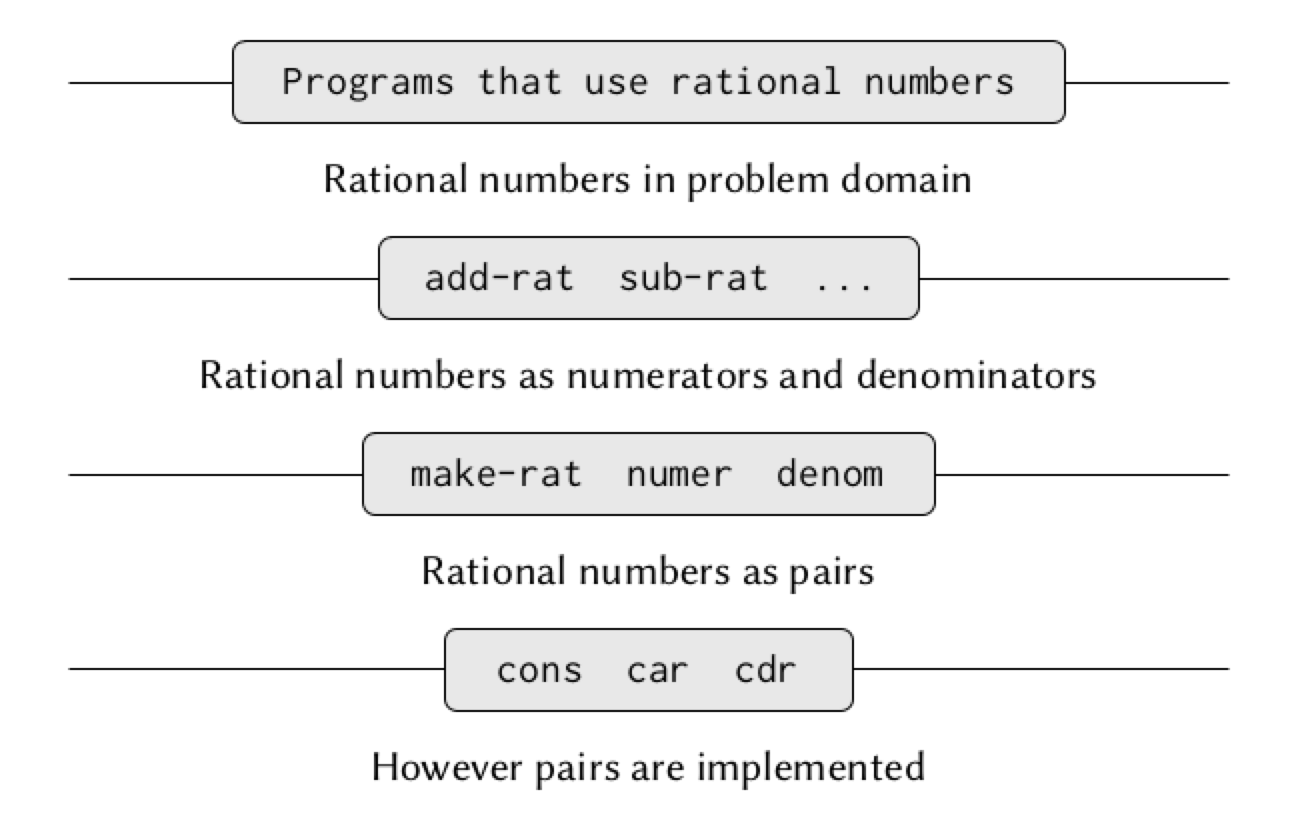SICP Chapter 2
Building Abstractions with Data
Data Abstraction
Isolate two parts of a program
- Parts deal with how data objects are represented
- Parts deal with how data objects are used
Selectors, Constructors
Interface between programs and data definition.
- selector
- select data attributes
- constructor
- construct data objects
list-structured data
Data objects constructed from Pair (compound-data primitive)
Abstraction Barriers
- use and only allow a basic set of operations to manipulate the data
- each layer uses procedures exposed by underlying layers (interface procedures)
- make programs much easier to maintain and to modify

Example: Arithmetic Operations fro Rational Numbers
(define (make-rat n d)
(let ((g ((if (< d 0) - +) (gcd n d))))
(cons (/ n g) (/ d g))))
(define (numer x) (car x))
(define (denom x) (cdr x))
(define (add-rat x y)
(make-rat (+ (* (numer x) (denom y))
(* (numer y) (denom x)))
(* (denom x) (denom y))))
(define (print-rat x)
(newline)
(display (numer x))
(display "/")
(display (denom x)))
Exercises
What is data
- procedures (selectors and constuctors)
plus conditions (procedures must fulfill to be a valid representation)
- -> procedures/implementations can have many forms, as long as they comply with the conditions
- define new kinds of data objects in terms of previously defined types of data objects
Rational Number Example:
Procedures must meet the requirement below
(numer x) n --------- = --- (denom x) dCondition above rely on representation of integer
Exercises
Exercise 2.4 - Alternative Implementation of Cons, Car, Cdr use Applicative order
Exercise 2.5 - Represent non-negative int using only number and arithmetic operations
Exercise 2.6 - Define numbers and addition without numbers Church Numeral
Hierarchical Data and the Closure Property
Closure Property of Cons
- create pairs whose elements are pairs
- an operation for combining data objects satisfies the closure property if the results of combining things with that operation can be combined using the same operation
- allows to create hierarchical structure - parts made up of parts
Sequences
List
- a sequence of pairs, formed by nested
cons (list 1 2 3 4)equals to(cons 1 (cons 2 (cons 3 (cons 4 nil))))
access an element
(define (list-ref items n) (if (= n 0) (car items) (list-ref (cdr items) (- n 1)))) (define squares (list 1 4 9 16 25)) (list-ref squares 3) 16
get a list’s length
(define (length items) (define (length-iter a count) (if (null? a) count (length-iter (cdr a) (+ 1 count)))) (length-iter items 0))
append
(define (append list1 list2) (if (null? list1) list2 (cons (car list1) (append (cdr list1) list2))))
- a sequence of pairs, formed by nested